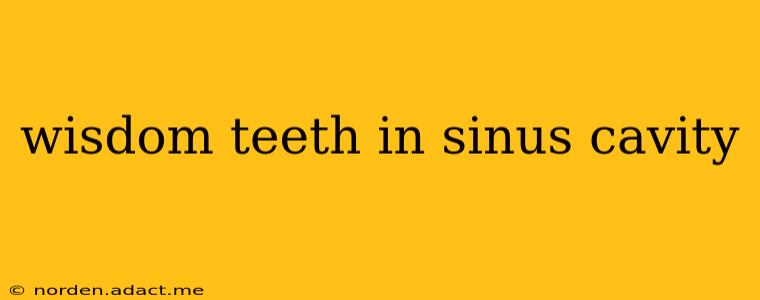Wisdom teeth, also known as third molars, are the last teeth to erupt in the mouth, typically appearing between the ages of 17 and 25. While many people have wisdom teeth that erupt normally without issue, some individuals experience complications due to their position and proximity to other structures, including the maxillary sinuses. This article explores the potential problems that arise when wisdom teeth are located near or within the sinus cavity.
What Happens When a Wisdom Tooth Impinges on the Sinus?
When a wisdom tooth's roots are close to or even within the maxillary sinus (the air-filled cavity located above the upper molars), several problems can occur. The proximity itself isn't always problematic, but complications arise when the tooth becomes impacted (unable to fully erupt), infected, or requires extraction.
Potential Complications:
- Sinusitis: Infection of the wisdom tooth can easily spread to the maxillary sinus, leading to sinusitis. Symptoms include facial pain, pressure, headaches, nasal congestion, and possibly fever.
- Sinus perforation: During wisdom tooth extraction, particularly if the tooth is deeply impacted and close to the sinus, there's a risk of accidentally perforating (creating a hole in) the sinus lining. This can lead to post-operative sinus pain, infections, and sometimes requires additional procedures to close the perforation.
- Oro-antral fistula: This is a communication between the mouth and the maxillary sinus, often resulting from a complication after a wisdom tooth extraction. An orofacial fistula allows for the passage of food, bacteria and fluids between the oral cavity and the sinus.
- Delayed healing: The proximity of the tooth to the sinus may result in slower healing after extraction due to the close proximity of the delicate sinus membrane.
How Common is it for Wisdom Teeth to be in the Sinus Cavity?
The frequency with which wisdom teeth are located near or within the sinus cavity varies depending on individual anatomy. While many people have wisdom teeth situated far enough away from the sinus to avoid complications, a significant portion experience close proximity which necessitates careful consideration during assessment and treatment. A panoramic X-ray is essential to evaluate the relationship between the wisdom teeth and the maxillary sinuses before any extraction is performed.
How is the proximity of wisdom teeth to the sinus cavity diagnosed?
Dental professionals employ several diagnostic techniques to assess the position of wisdom teeth relative to the maxillary sinuses:
- Panoramic radiography: This provides a comprehensive view of the entire jaw, allowing dentists to visualize the roots of the wisdom teeth and their proximity to the sinus floor.
- Cone beam computed tomography (CBCT): A CBCT scan offers a highly detailed 3D image, providing a more precise assessment of the relationship between the teeth and the sinus. This is often used in complex cases.
- Clinical examination: A thorough clinical examination helps assess the presence of any swelling, infection, or other signs that might indicate the involvement of the sinus.
What are the treatment options for impacted wisdom teeth near the sinus?
The treatment plan for impacted wisdom teeth near the sinus depends on several factors, including the tooth's position, the degree of impaction, the presence of infection, and the patient's overall health. Options include:
- Observation: In some cases, especially if the tooth is asymptomatic and poses no immediate threat, observation may be recommended. Regular check-ups are vital to monitor any changes.
- Extraction: If the wisdom tooth is impacted, causing pain, infection, or poses a risk to the sinus, extraction is typically necessary. This might involve surgical extraction if the tooth is deeply impacted.
- Root canal treatment (in rare cases): If the tooth is infected but not impacting the sinus, a root canal may be done. However, this is typically less common given the long term risks.
Can sinus issues develop after wisdom tooth extraction?
Yes, post-operative complications such as sinusitis or an orofacial fistula can occur following wisdom tooth extraction, especially if the tooth was close to or within the sinus. Careful surgical technique and post-operative care are essential to minimize this risk. Symptoms should be reported to a dental professional immediately.
How can I reduce the risk of complications?
Choosing a qualified oral surgeon or dentist with experience managing impacted wisdom teeth is crucial. They can properly assess the risk and execute the procedure with precision. Following post-operative instructions carefully is also essential for minimizing the chances of developing complications such as infections.
This information is for general knowledge and does not constitute medical advice. Always consult with a qualified dental professional for any concerns regarding your wisdom teeth. They can provide a personalized assessment and recommend the best course of action based on your individual circumstances.
